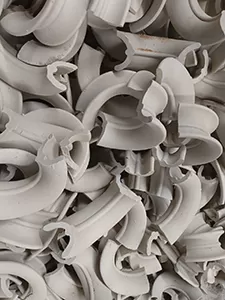Intalox saddle packing model selection directly affects separation efficiency, operational stability, and cost-effectiveness in industrial processes. The process requires comprehensive consideration of material properties, structural parameters, operating conditions, and application scenarios to match the optimal packing type.

Material Selection Based on Corrosiveness and Temperature
Material is the primary factor in model selection. Ceramic Intalox saddles, with excellent corrosion resistance to acids, alkalis, and organic solvents, are suitable for corrosive environments such as sulfuric acid absorption and wastewater treatment, but they are brittle and not resistant to severe impact. Metal variants (carbon steel, stainless steel, nickel alloys) offer high mechanical strength and temperature resistance (-200°C to 600°C), ideal for high-pressure, high-temperature processes like petroleum distillation, though they are prone to corrosion in strong acid/alkali media. Plastic saddles (PP, PVC, PVDF) are lightweight and cost-effective, applicable to low-temperature (≤120°C) and non-strong oxidizing conditions such as water treatment and food processing, but they have poor high-temperature resistance.
Specification Selection by Process Requirements
Specific surface area and size determine mass transfer efficiency and pressure drop. Small-sized packings (16mm, 25mm) with high specific surface area (≥200 m²/m³) enhance gas-liquid contact, suitable for high-purity separation processes like fine chemical distillation, but they cause higher pressure drop. Large-sized variants (50mm, 76mm) with lower specific surface area (≤100 m²/m³) reduce resistance, making them suitable for high-flux applications such as gas absorption in large columns, though their mass transfer efficiency is slightly lower. The 38mm size balances efficiency and pressure drop, serving as a universal choice for most general separation processes.
Adaptation to Operating Conditions
Operating parameters like temperature, pressure, and fluid properties must be matched. For high-temperature processes (>300°C), metal or high-alumina ceramic saddles are preferred to avoid thermal deformation. In high-pressure columns, metal packings with high mechanical strength prevent crushing under load. For high-viscosity fluids (>50 cP), larger-sized packings with larger voids (≥0.85) are selected to reduce blockage risks. In systems with frequent temperature fluctuations, metal packings with better thermal shock resistance are more suitable than ceramics to prevent cracking.
Consideration of Cost and Maintenance
Cost-effectiveness should be balanced with performance. Plastic saddles have the lowest initial cost but require frequent replacement in harsh conditions, suitable for short-term or low-budget projects. ceramic packings have moderate costs and long lifespans in corrosive environments, offering good overall economy. Metal packings have higher upfront investment but excel in long-term high-load operations, justifying the cost in large-scale industrial plants. Additionally, maintenance factors should be considered: plastic and metal packings are easier to install and replace than fragile ceramics, reducing downtime costs.
Verification by Pilot Tests
For critical or complex processes, pilot tests are recommended to confirm model selection. Testing different materials and sizes under simulated operating conditions helps evaluate actual mass transfer efficiency, pressure drop, and anti-fouling performance. For example, in pharmaceutical solvent recovery, testing 25mm ceramic vs. 38mm stainless steel saddles can determine the optimal choice based on purity and energy consumption data, ensuring the selected packing meets both technical and economic requirements.

